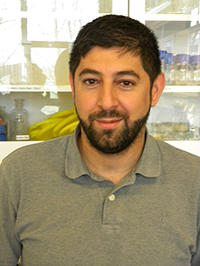CAZypedia needs your help! We have many unassigned GH, PL, CE, AA, GT, and CBM pages in need of Authors and Responsible Curators.
Scientists at all career stages, including students, are welcome to contribute to CAZypedia. Read more here, and in the 10th anniversary article in Glycobiology.
New to the CAZy classification? Read this first.
*
Consider attending the 15th Carbohydrate Bioengineering Meeting in Ghent, 5-8 May 2024.
Difference between revisions of "User:Maher Abou Hachem"
Harry Brumer (talk | contribs) m |
|||
| Line 2: | Line 2: | ||
'''This is an empty template to help you get started with composing your User page.''' | '''This is an empty template to help you get started with composing your User page.''' | ||
| − | I have received my PhD from Lund University in 2003, where I described the first xylan-specific CBM4 from a GH10 thermostable xylanase <cite>AbouHachem2000</cite>. I moved to the other side of the Øresund canal to start a post-doc at the Carlsberg Research Center in the laboratory of Professor Birte Svensson in Copenhagen, working on barley α-amylases and other GH13 enzymes. Thereafter, I moved to the Technical University of Denmark, where I am a Professor MSO at the the [https://www.bioengineering.dtu.dk/ Department of Biotechnology and Bioengineering], since 2018. I have been fascianted by fungal enzymes, especially oxidoreductases secreted during growth on polysaccharides <cite>NekiunaiteL</cite>. | + | I have received my PhD from Lund University in 2003, where I described the first xylan-specific CBM4 from a GH10 thermostable xylanase <cite>AbouHachem2000</cite>. I moved to the other side of the Øresund canal to start a post-doc at the Carlsberg Research Center in the laboratory of Professor ^^^Birte Svensson^^^ in Copenhagen, working on barley α-amylases and other GH13 enzymes. Thereafter, I moved to the Technical University of Denmark, where I am a Professor MSO at the the [https://www.bioengineering.dtu.dk/ Department of Biotechnology and Bioengineering], since 2018. I have been fascianted by fungal enzymes, especially oxidoreductases secreted during growth on polysaccharides <cite>NekiunaiteL</cite>. |
| − | Most of my research has, however, been focused on understanding the protein machinery, especially oligosaccharide transporters, conferring glycan utilisation by members of the human gut microbiota including lactobacilli <cite>TheilmannMC2017</cite>, bifidobacteria <cite>SakanakaMC2019 | + | Most of my research has, however, been focused on understanding the protein machinery, especially oligosaccharide transporters, conferring glycan utilisation by members of the human gut microbiota including lactobacilli <cite>TheilmannMC2017</cite>, bifidobacteria <cite>SakanakaMC2019 EjbyH2019 TheilmannMC2019</cite> and clostridia <cite>LaRosaL2018 LethML2018</cite>. |
| − | |||
| − | |||
| − | |||
---- | ---- | ||
| Line 13: | Line 10: | ||
<biblio> | <biblio> | ||
#AbouHachem2000 pmid=10600638 | #AbouHachem2000 pmid=10600638 | ||
| − | |||
#NekiunaiteL pmid=27588040 | #NekiunaiteL pmid=27588040 | ||
| − | |||
#TheilmannMC2017 pmid=29162708 | #TheilmannMC2017 pmid=29162708 | ||
| − | |||
#SakanakaMC2019 pmid=31489370 | #SakanakaMC2019 pmid=31489370 | ||
#TheilmannMC2019 pmid=31186348 | #TheilmannMC2019 pmid=31186348 | ||
Revision as of 10:23, 7 February 2020
This is an empty template to help you get started with composing your User page.
I have received my PhD from Lund University in 2003, where I described the first xylan-specific CBM4 from a GH10 thermostable xylanase [1]. I moved to the other side of the Øresund canal to start a post-doc at the Carlsberg Research Center in the laboratory of Professor ^^^Birte Svensson^^^ in Copenhagen, working on barley α-amylases and other GH13 enzymes. Thereafter, I moved to the Technical University of Denmark, where I am a Professor MSO at the the Department of Biotechnology and Bioengineering, since 2018. I have been fascianted by fungal enzymes, especially oxidoreductases secreted during growth on polysaccharides [2]. Most of my research has, however, been focused on understanding the protein machinery, especially oligosaccharide transporters, conferring glycan utilisation by members of the human gut microbiota including lactobacilli [3], bifidobacteria [4, 5, 6] and clostridia [7, 8].
- Abou Hachem M, Nordberg Karlsson E, Bartonek-Roxâ E, Raghothama S, Simpson PJ, Gilbert HJ, Williamson MP, and Holst O. (2000). Carbohydrate-binding modules from a thermostable Rhodothermus marinus xylanase: cloning, expression and binding studies. Biochem J. 2000;345 Pt 1(Pt 1):53-60. | Google Books | Open Library
- Nekiunaite L, Arntzen MØ, Svensson B, Vaaje-Kolstad G, and Abou Hachem M. (2016). Lytic polysaccharide monooxygenases and other oxidative enzymes are abundantly secreted by Aspergillus nidulans grown on different starches. Biotechnol Biofuels. 2016;9(1):187. DOI:10.1186/s13068-016-0604-0 |
- Theilmann MC, Goh YJ, Nielsen KF, Klaenhammer TR, Barrangou R, and Abou Hachem M. (2017). Lactobacillus acidophilus Metabolizes Dietary Plant Glucosides and Externalizes Their Bioactive Phytochemicals. mBio. 2017;8(6). DOI:10.1128/mBio.01421-17 |
- Sakanaka M, Hansen ME, Gotoh A, Katoh T, Yoshida K, Odamaki T, Yachi H, Sugiyama Y, Kurihara S, Hirose J, Urashima T, Xiao JZ, Kitaoka M, Fukiya S, Yokota A, Lo Leggio L, Abou Hachem M, and Katayama T. (2019). Evolutionary adaptation in fucosyllactose uptake systems supports bifidobacteria-infant symbiosis. Sci Adv. 2019;5(8):eaaw7696. DOI:10.1126/sciadv.aaw7696 |
- Ejby M, Guskov A, Pichler MJ, Zanten GC, Schoof E, Saburi W, Slotboom DJ, and Abou Hachem M. (2019). Two binding proteins of the ABC transporter that confers growth of Bifidobacterium animalis subsp. lactis ATCC27673 on β-mannan possess distinct manno-oligosaccharide-binding profiles. Mol Microbiol. 2019;112(1):114-130. DOI:10.1111/mmi.14257 |
- Theilmann MC, Fredslund F, Svensson B, Lo Leggio L, and Abou Hachem M. (2019). Substrate preference of an ABC importer corresponds to selective growth on β-(1,6)-galactosides in Bifidobacterium animalis subsp. lactis. J Biol Chem. 2019;294(31):11701-11711. DOI:10.1074/jbc.RA119.008843 |
- La Rosa SL, Leth ML, Michalak L, Hansen ME, Pudlo NA, Glowacki R, Pereira G, Workman CT, Arntzen MØ, Pope PB, Martens EC, Hachem MA, and Westereng B. (2019). The human gut Firmicute Roseburia intestinalis is a primary degrader of dietary β-mannans. Nat Commun. 2019;10(1):905. DOI:10.1038/s41467-019-08812-y |
- Leth ML, Ejby M, Workman C, Ewald DA, Pedersen SS, Sternberg C, Bahl MI, Licht TR, Aachmann FL, Westereng B, and Abou Hachem M. (2018). Differential bacterial capture and transport preferences facilitate co-growth on dietary xylan in the human gut. Nat Microbiol. 2018;3(5):570-580. DOI:10.1038/s41564-018-0132-8 |
